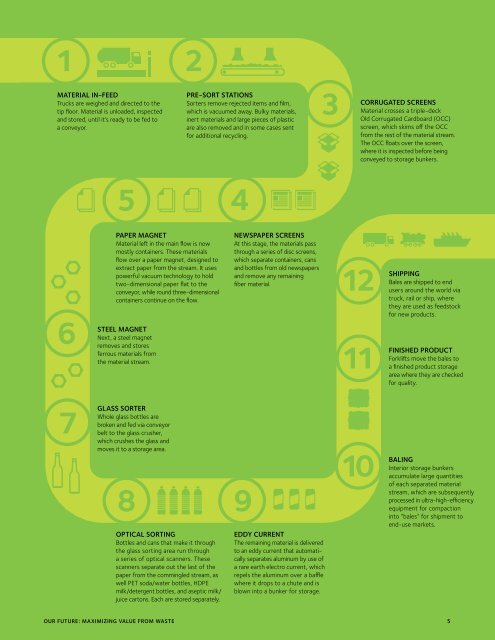2012 Sustainability Report - Executive Summary - Waste Management
2012 Sustainability Report - Executive Summary - Waste Management
2012 Sustainability Report - Executive Summary - Waste Management
Create successful ePaper yourself
Turn your PDF publications into a flip-book with our unique Google optimized e-Paper software.
1 2<br />
Material in-feed<br />
Trucks are weighed and directed to the<br />
tip floor. Material is unloaded, inspected<br />
and stored, until it’s ready to be fed to<br />
a conveyor.<br />
pre-sort stations<br />
Sorters remove rejected items and film,<br />
which is vacuumed away. Bulky materials,<br />
inert materials and large pieces of plastic<br />
are also removed and in some cases sent<br />
for additional recycling.<br />
3<br />
Corrugated screens<br />
Material crosses a triple-deck<br />
Old Corrugated Cardboard (OCC)<br />
screen, which skims off the OCC<br />
from the rest of the material stream.<br />
The OCC floats over the screen,<br />
where it is inspected before being<br />
conveyed to storage bunkers.<br />
5<br />
4<br />
6<br />
Paper magnet<br />
Material left in the main flow is now<br />
mostly containers. These materials<br />
flow over a paper magnet, designed to<br />
extract paper from the stream. It uses<br />
powerful vacuum technology to hold<br />
two-dimensional paper flat to the<br />
conveyor, while round three-dimensional<br />
containers continue on the flow.<br />
Steel magnet<br />
Next, a steel magnet<br />
removes and stores<br />
ferrous materials from<br />
the material stream.<br />
Newspaper screens<br />
At this stage, the materials pass<br />
through a series of disc screens,<br />
which separate containers, cans<br />
and bottles from old newspapers<br />
and remove any remaining<br />
fiber material.<br />
12<br />
11<br />
Shipping<br />
Bales are shipped to end<br />
users around the world via<br />
truck, rail or ship, where<br />
they are used as feedstock<br />
for new products.<br />
Finished product<br />
Forklifts move the bales to<br />
a finished product storage<br />
area where they are checked<br />
for quality.<br />
7<br />
Glass sorter<br />
Whole glass bottles are<br />
broken and fed via conveyor<br />
belt to the glass crusher,<br />
which crushes the glass and<br />
moves it to a storage area.<br />
8 9<br />
Optical sorting<br />
Bottles and cans that make it through<br />
the glass sorting area run through<br />
a series of optical scanners. These<br />
scanners separate out the last of the<br />
paper from the commingled stream, as<br />
well PET soda/water bottles, HDPE<br />
milk/detergent bottles, and aseptic milk/<br />
juice cartons. Each are stored separately.<br />
Eddy current<br />
The remaining material is delivered<br />
to an eddy current that automatically<br />
separates aluminum by use of<br />
a rare earth electro current, which<br />
repels the aluminum over a baffle<br />
where it drops to a chute and is<br />
blown into a bunker for storage.<br />
10<br />
Baling<br />
Interior storage bunkers<br />
accumulate large quantities<br />
of each separated material<br />
stream, which are subsequently<br />
processed in ultra-high-efficiency<br />
equipment for compaction<br />
into “bales” for shipment to<br />
end-use markets.<br />
OUR FUTURE: maximizing value from waste 5
















